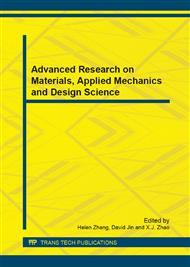[1]
Fujishima A, Honda K.Electrochemical photolysis of water at a semiconductor Electrode, Nature, 1972, 238(5358): 37~ 38
DOI: 10.1038/238037a0
Google Scholar
[2]
Wang Ziyin. Studies of Electroless Plating on Self-assembled Monolayer and Its Applications Preparation of the TiO2 photocatalytic material and its application in environmental purification. Southeast University. 2003. 03. 01
Google Scholar
[3]
Ding Shifeng, Tang Chaoqun. Photocatalytic degradation of contamination by using nano-TiO2. Department of Physics, Huazhong University of Science and Technology, Machinery Technical School of Hubei. 2003. 03. 25
Google Scholar
[4]
Huili Yu, Kaili Zhang, Carole Rossi. Study of formaldehyde photocatalytic degradation using nano-TiO2. Ocean Univ. of China (China), LAAS-CNRS (France) November 01, (2007)
Google Scholar
[5]
Rui Guo. The study of photocatalyst spray purifying air pollution Beijing university of chemical industry. 2007. 06. 03
Google Scholar
[6]
Geng Shibin, Li Jintian. The Analysis of Nano-TiO2 photocatalysis mechanism and application. School of Engineering, PLA University of Science and Technology. 2005. 9. 28
Google Scholar
[7]
Wang Jisen, Feng Zhongbin, Sun Jinquan, Jia Mingjian, Song Zhenlei. Photocatalytic Mechanism of Nano-TiO2 and Analysis on Factors Influencing Its Photocatalytic Activity. College of Mechanical Engineering, College of Materials Engineering, Shandong University of Science and Technology. 2008. 1. 15
Google Scholar
[8]
Lowney, J. R. ,Larrabee, R.D. The use of Fick's law in modeling diffusion processes. (1980)
Google Scholar
[9]
He Longqing, Lin Jichen, Shi Bing. Fick law and the diffusion's thermodynamics theory.Physics Dept. of Nanjing Xiaozhuang College, School of Physics and Electrical Engineering, Anqing Teachers college. 2006. 11. 15
Google Scholar
[10]
Liu Fei, Su Yunxing, Wang Zhongmin, Pan Shunkang.Application of Fick's law in measurement of hydrogen diffusion coefficient by electrochemical method. Guilin University of Electronic Science and Technology, School of Materials Science and Engineering. 2010. 10. 20
Google Scholar
[11]
Wang Wenjia, Shi Chao'ou, Xu Fangyuan, XIE Yulin, WANG Rong, YIN Xue-mei. Determination of Passive Diffusion Coefficient of Formaldehyde in Passive Sampler. Analysis and Research Center of East China University of Science and Technology. 2012. 7. 5
Google Scholar
[12]
Zheng Guanghong, Feng Xining, Fu Hongbin, Zhang Xugui. Application of Nano Titanium Oxide as Photocatalyst. Chengdu Textile institute. 2004. 10
Google Scholar


